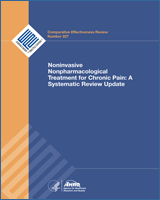From: Results

NCBI Bookshelf. A service of the National Library of Medicine, National Institutes of Health.
| Author, Year, Followup,a Pain Duration, Study Quality | Intervention | Population | Function and Pain Outcomes | Other Outcomes |
|---|---|---|---|---|
Viljanen, 200345 3 and 9 months Pain duration: 11 years Fair | A. Physical therapist guided relaxation training (n=128): progressive relaxation, autogenic training, functional relaxation, and systematic desensi-tization (goal was to teach correct activation and relaxation of muscles used in daily activities); 3 times per week for 12 weeks, 30 minute sessions B. Physical therapist guided dynamic strengthening exercises of the shoulder and cervical musculature (muscle performance exercises) (n=135): 3 times per week for 12 weeks, 30 minute sessions C. No intervention (n=130) | A vs. B vs. C Age: 43 vs. 45 vs. 44 years Female: 100% Performing physical activity ≥3x/week: 34% vs. 44% vs. 41% Duration of office work: 20 vs. 23 vs. 21 years Sedentary work >6 hours per day: 75% vs. 76% vs. vs. 73% Computer work >6 hours per day: 39% vs. 33% vs. vs. 35% Absent from work due to neck pain: 12% vs. 12% vs. 12% Pain duration: 11 vs. 11 vs. 10 years Depression index: 16 vs. 16 vs. 16 Baseline neck disability scalea (0-80): 29 vs. 29 vs. 26 Baseline pain (0-10 VAS): 4.8 vs. 4.8 vs. 4.1 | A vs. C 3 months Neck disability scaleb: 15 vs. 14, adjusted difference 0.1 (95% CI −2.9 to 3.2) Pain VAS: 3.0 vs. 2.9, adjusted difference 0.2 (95% CI −0.4 to 0.8) 9 months Neck disability scaleb: 19 vs. 17, adjusted difference 0.2 (95% CI −2.8 to 3.1) Pain VAS: 3.3 vs. 3.2, adjusted difference 0.2 (95% CI −0.3 to 0.8) A vs. B 3 months Neck disability scalea: 15 vs. 15, adjusted difference 0.2 (95% CI −2.8 to 3.2) Pain VAS: 3.0 vs. 2.9, adjusted difference −0.2 (95% CI −0.8 to 0.4) 9 months Neck disability scalea: 19 vs. 19; adjusted difference 0.2 (95% CI −2.7 to 3.2) Pain VAS: 3.3 vs. 3.1, adjusted difference −0.2 (95% CI −0.8 to 0.3) | NR |
Unless otherwise noted, followup time is calculated from the end of the treatment period
Neck disability scale was created by investigators from responses to eight questions related to functional limitations due to pain. This scale is not the same as the more common Neck Disability Index (NDI)
From: Results

NCBI Bookshelf. A service of the National Library of Medicine, National Institutes of Health.